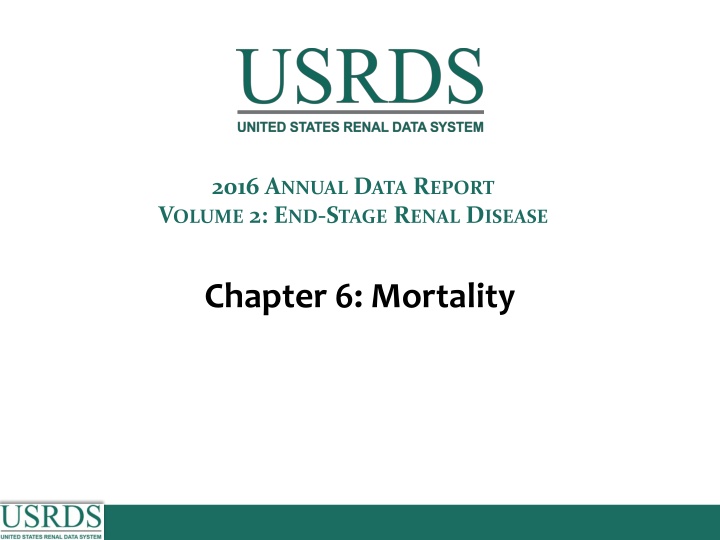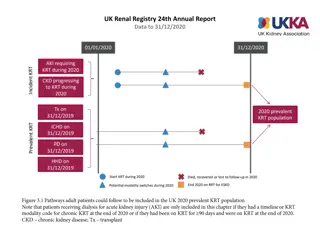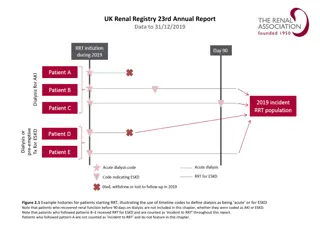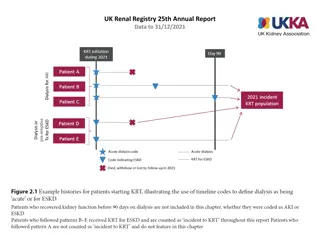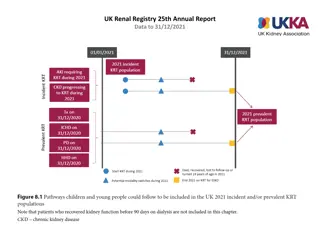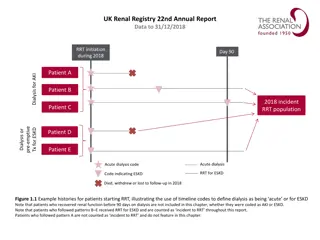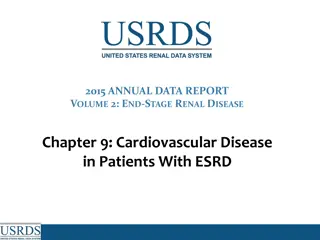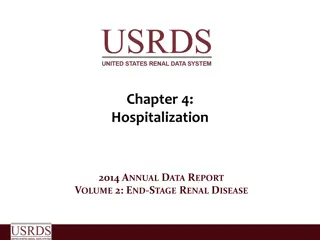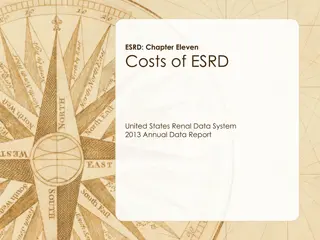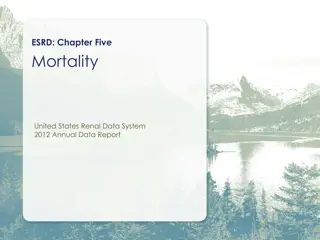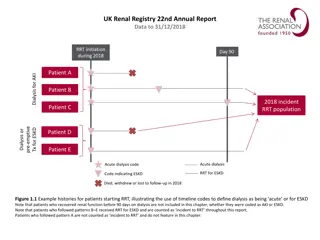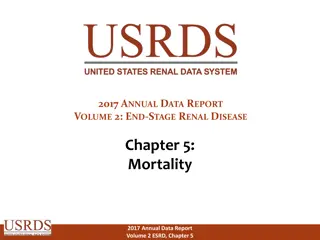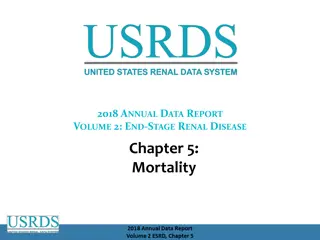2016 Annual Data Report: End-Stage Renal Disease Mortality Trends
The report analyzes mortality rates in end-stage renal disease (ESRD) patients undergoing dialysis and transplantation from 1996 to 2014. It provides insights into all-cause mortality based on treatment modality, cohort year, and number of years post-dialysis initiation. The data is adjusted for various factors such as age, sex, race, and primary diagnosis. The findings aim to contribute to improving patient outcomes and guiding healthcare decision-making in ESRD management.
Download Presentation

Please find below an Image/Link to download the presentation.
The content on the website is provided AS IS for your information and personal use only. It may not be sold, licensed, or shared on other websites without obtaining consent from the author.If you encounter any issues during the download, it is possible that the publisher has removed the file from their server.
You are allowed to download the files provided on this website for personal or commercial use, subject to the condition that they are used lawfully. All files are the property of their respective owners.
The content on the website is provided AS IS for your information and personal use only. It may not be sold, licensed, or shared on other websites without obtaining consent from the author.
E N D
Presentation Transcript
2016 ANNUAL DATA REPORT VOLUME 2: END-STAGE RENAL DISEASE Chapter 6: Mortality
Figure 6.1.a Adjusted all-cause mortality (deaths per 1,000 patient-years) by treatment modality: overall, dialysis, and transplant for period-prevalent patients, 1996-2014 Data Source: Reference Tables H.2_adj, H4_adj, H.8_adj, H.9_adj, and H.10_adj; and special analyses, USRDS ESRD Database. Adjusted for age, sex, race, ethnicity, primary diagnosis, and vintage. Reference population: period prevalent ESRD patients, 2011. Abbreviations: HD, hemodialysis; PD, peritoneal dialysis. 2016 Annual Data Report, Vol 2, ESRD, Ch 6 2
Figure 6.1.b Adjusted all-cause mortality (deaths per 1,000 patient-years) by treatment modality: hemodialysis and peritoneal dialysis, for period-prevalent patients, 1996-2014 Data Source: Reference Tables H.2_adj, H4_adj, H.8_adj, H.9_adj, and H.10_adj; and special analyses, USRDS ESRD Database. Adjusted for age, sex, race, ethnicity, primary diagnosis, and vintage. Reference population: period prevalent ESRD patients, 2011. Abbreviations: HD, hemodialysis; PD, peritoneal dialysis. 2016 Annual Data Report, Vol 2, ESRD, Ch 6 3
Figure 6.2.a Adjusted all-cause mortality (deaths per 1,000 patient-years) by treatment modality, cohort (year of ESRD onset), and number of years after start of dialysis among incident hemodialysis patients, 1996, 2001, 2006, and 2011 Data Source: Special analyses, USRDS ESRD Database. Adjusted for age, sex, race, and primary diagnosis. Reference population: period prevalent ESRD patients, 2011. Abbreviation: ESRD, end-stage renal disease. 2016 Annual Data Report, Vol 2, ESRD, Ch 6 4
Figure 6.2.b Adjusted all-cause mortality (deaths per 1,000 patient-years) by treatment modality, cohort (year of ESRD onset), and number of years after start of dialysis among incident peritoneal dialysis patients, 1996, 2001, 2006, and 2011 Data Source: Special analyses, USRDS ESRD Database. Adjusted for age, sex, race, and primary diagnosis. Reference population: period prevalent ESRD patients, 2011. Abbreviation: ESRD, end-stage renal disease. 2016 Annual Data Report, Vol 2, ESRD, Ch 6 5
Figure 6.3.a Adjusted mortality (deaths per 1000 patient-years) by treatment modality and number of months after treatment initiation among ESRD patients, under age 65, 2013 Data Source: Special analyses, USRDS ESRD Database. Adjusted (age, race, sex, ethnicity, and primary diagnosis) mortality among 2013 incident ESRD patients during the first year of therapy. Reference population: incident ESRD patients, 2011. Abbreviations: ESRD, end-stage renal disease; HD, hemodialysis; PD, peritoneal dialysis. 2016 Annual Data Report, Vol 2, ESRD, Ch 6 6
Figure 6.3.b Adjusted mortality (deaths per 1000 patient-years) by treatment modality and number of months after treatment initiation among ESRD patients, aged 65 and over, 2013 Data Source: Special analyses, USRDS ESRD Database. Adjusted (age, race, sex, ethnicity, and primary diagnosis) mortality among 2013 incident ESRD patients during the first year of therapy. Reference population: incident ESRD patients, 2011. Abbreviations: ESRD, end-stage renal disease; HD, hemodialysis; PD, peritoneal dialysis. 2016 Annual Data Report, Vol 2, ESRD, Ch 6 7
Figure 6.4 Adjusted mortality (deaths per 1,000 patient-years) by calendar year, treatment modality, and Medicare comorbidity among ESRD patients and comorbidity- specific Medicare populations aged 65 & older, 1996-2014 Data Source: Special analyses, USRDS ESRD Database, and Medicare 5% sample. Unadjusted and adjusted (sex and race) mortality rates starting with the January 1 point prevalent sample in the ESRD and general populations, aged 65 and older (per 1,000 patient-years at risk). Reference population: period prevalent ESRD patients, 2012. Abbreviations: AMI, acute myocardial infarction; CHF, congestive heart failure; CVA/TIA, cerebrovascular accident/transient ischemic attack; ESRD, end-stage renal disease. 2016 Annual Data Report, Vol 2, ESRD, Ch 6 8
Table 6.1.a Adjusted all-cause mortality (deaths per 1,000 patient-years) by age and race, among ESRD patients, 2014 Age 0-21 Race White Black/African American Other White Black/African American Other White Black/African American Other White Black/African American Other White Black/African American Other ESRD 10 18 8 33 43 20 108 98 77 209 171 139 357 270 233 Dialysis 33 35 26 64 54 37 155 112 102 249 185 161 377 276 240 Transplant 4 6 4 9 11 4 35 34 20 80 79 59 136 143 111 22-44 45-64 65-74 75+ Data Source: Special analyses, USRDS ESRD Database. Adjusted (race and primary diagnosis) all-cause mortality among 2014 period prevalent patients. Reference population: period prevalent ESRD patients, 2011. Abbreviation: ESRD, end- stage renal disease. 2016 Annual Data Report, Vol 2, ESRD, Ch 6 9
Table 6.1.b Adjusted all-cause mortality (deaths per 1,000 patient-years) by age and sex, among ESRD patients, 2014 (continued) Age Sex ESRD Dialysis Transplant 0-21 Male 9 31 3 Female 12 36 4 22-44 Male Female 34 39 56 66 9 10 45-64 Male 105 141 36 Female 107 144 31 65-74 Male 205 245 83 Female 196 224 74 75+ Male 357 379 140 Female 330 342 129 Data Source: Special analyses, USRDS ESRD Database. Adjusted (sex and primary diagnosis) all-cause mortality among 2014 period prevalent patients. Reference population: period prevalent ESRD patients, 2011. Abbreviation: ESRD, end-stage renal disease. 2016 Annual Data Report, Vol 2, ESRD, Ch 6 10
Table 6.2 Unadjusted percentages of deaths due to cardiovascular disease (CVD), infection, other specified causes, and with missing data, by modality among ESRD patients, 2013 Cause-specific mortality Infection CVD Other cause Missing cause Modality ESRD Dialysis Transplant 39% 41% 9% 8% 8% 5% 25% 26% 13% 28% 24% 73% Data Source: Special analyses, USRDS ESRD Database. All-cause mortality among 2012 prevalent patients. Reference population: period prevalent ESRD patients, 2011. Abbreviations: CVD, cardiovascular disease; ESRD, end-stage renal disease. 2016 Annual Data Report, Vol 2, ESRD, Ch 6 11
Table 6.3 Adjusted survival (%) by treatment modality and incident cohort year (year of ESRD onset): Dialysis 3 months 12 months 24 months 36 months 60 months Hemodialysis 2001 2003 2005 2007 2009 Peritoneal dialysis 2001 2003 2005 2007 2009 91.0 91.0 91.2 91.5 91.7 74.8 74.8 75.4 76.3 77.4 61.4 61.8 62.7 64.1 65.6 50.8 51.4 52.9 54.6 56.1 35.6 36.5 38.5 39.9 41.5 95.5 96.3 96.4 96.9 97.3 82.1 83.9 85.6 87.5 87.8 67.3 69.0 72.3 74.8 76.5 55.4 57.7 61.6 64.6 66.5 39.4 42.9 45.7 49.0 51.4 Data Source: Reference Tables I.1_adj-I.36_adj. Adjusted survival probabilities, from day one, in the ESRD population. Reference population: incident ESRD patients, 2011. Adjusted for age, sex, race, Hispanic ethnicity, and primary diagnosis. Abbreviation: ESRD, end-stage renal disease. 2016 Annual Data Report, Vol 2, ESRD, Ch 6 12
Table 6.3 Adjusted survival (%) by treatment modality and incident cohort year (year of ESRD onset): Transplant (continued) 3 months 12 months 24 months 36 months 60 months Deceased-donor transplant 2001 2003 2005 2007 2009 Living donor transplant 2001 2003 2005 2007 2009 94.9 95.7 95.6 96.7 96.8 89.4 90 89.9 92.3 92.3 83.2 84.6 85.1 88.1 88.5 77.8 79.5 80.5 83.7 84.3 66.1 69.2 71.3 73.3 75.7 97.3 98.1 98.2 99.1 98.9 93.6 95.6 95.3 97.2 97.1 89.6 91.9 92.0 94.8 94.5 85.5 87.8 88.7 91.9 91.4 76.0 79.3 81.0 85.1 84.6 Data Source: Reference Tables I.1_adj-I.36_adj. Adjusted survival probabilities, from day one, in the ESRD population. Reference population: incident ESRD patients, 2011. Adjusted for age, sex, race, Hispanic ethnicity, and primary diagnosis. Abbreviation: ESRD, end-stage renal disease. 2016 Annual Data Report, Vol 2, ESRD, Ch 6 13
Table 6.4 Expected remaining lifetime (years) by age, sex, and treatment modality of prevalent dialysis patients, prevalent transplant patients, and the general U.S. population (2013), based on USRDS data and the National Vital Statistics Report (2016) 15-19 20-24 25-29 30-34 35-39 40-44 45-49 50-54 55-59 60-64 65-69 70-74 75-79 80-84 0-14 85+ Age Male 22.6 21.6 18.5 16.2 14.3 12.6 11.0 9.2 7.9 6.6 5.5 4.5 3.8 3.2 2.6 2.2 Dialysis ESRD Female 23.3 19.0 16.4 14.3 13.0 11.6 10.4 8.9 7.8 6.6 5.7 4.8 4.0 3.5 2.9 2.4 patients, 7.7a 8.7a Male 60.1 47.9 43.4 39.2 35.1 31 27.2 23.4 19.9 16.7 13.8 11.4 9.5 Female 59.8 48.5 44.2 40.2 36.4 32.8 28.9 25.2 21.7 18.3 15.3 12.6 10.4 2013 Transplant General U.S. population, 2013 Male 70.7 59.7 55.0 50.3 45.7 41.0 36.4 31.9 27.7 23.7 19.8 16.2 12.8 9.8 7.1 3.7 Female 75.4 64.4 59.5 54.6 49.7 45.0 40.3 35.6 31.1 26.8 22.6 18.5 14.7 11.3 8.4 4.4 Data Source: Reference Table H.13; special analyses, USRDS ESRD Database; and National Vital Statistics Report. Table 7. Life expectancy at selected ages, by race, Hispanic origin, race for non- Hispanic population, and sex: United States, 2013 (2016). Expected remaining lifetimes (years) of the general U.S. population and of period prevalent dialysis and transplant patients. aCell values combine ages 75+. Abbreviation: ESRD, end-stage renal disease. 2016 Annual Data Report, Vol 2, ESRD, Ch 6 14
Table 6.5 Adjusted mortality (deaths per 1,000 patient-years) by age, sex, treatment modality, and Medicare comorbidity among ESRD patients and people covered by Medicare in 2013, based on USRDS and CMS data, 2014 CVA/ All Age Sex Dialysis Transplant Cancer Diabetes CHF AMI Medicare 26 18 91 82 TIA 71 59 168 150 65-74 Male Female Male Female 228 215 345 324 64 53 119 119 75 67 139 134 41 31 110 101 106 102 236 220 92 97 206 205 75+ Data Source: Special analyses, USRDS ESRD Database and Medicare 5%sample. Adjusted for race. Medicare data limited to patients with at least one month of Medicare eligibility in 2013. Reference population: Medicare patients, 2014. Abbreviations: AMI, acute myocardial infarction; CHF, congestive heart failure; CMS, Centers for Medicare & Medicaid; CVA/TIA, cerebrovascular accident/transient ischemic attack; ESRD, end-stage renal disease. 2016 Annual Data Report, Vol 2, ESRD, Ch 6 15
